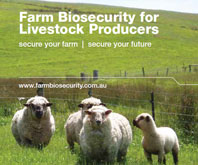Read the latest information on
Foot-and-mouth disease
 You couldn’t operate a farm without agricultural knowledge or build a fence without the right tools, so how could you implement biosecurity practices on your property without a basic understanding of what it involves?
You couldn’t operate a farm without agricultural knowledge or build a fence without the right tools, so how could you implement biosecurity practices on your property without a basic understanding of what it involves?
Fortunately, help is just a click away, with the Farm Biosecurity website providing farmers and industry stakeholders with access to a suite of free livestock biosecurity manuals, containing all the measures that can be used to reduce the risks of diseases entering or spreading amongst livestock.
AHA’s Executive Manager of Biosecurity Services, Duncan Rowland, said the manuals were key tools for livestock producers interested in implementing and performing sound biosecurity practices on their property and an important reference for farmers regardless of whether they were developing a biosecurity plan or looking for ways to enhance their existing biosecurity strategy.
“The manuals are important for producers because they provide easy-to-understand industry specific information they can apply on their own properties. The manuals are also excellent training tools for farmers to use when educating new staff,” Mr Rowland said.
The website supplies access to a number of livestock biosecurity manuals, covering everything from grazing industries to poultry production.
Mr Rowland said that it was important to note that the manuals were not a list of idealistic ‘must do’s’, but guides for producers to learn about biosecurity.
“The manuals are a broad set of guidelines that aim to prevent or reduce disease on farms, developed in consultation with industry bodies, researchers and government agencies. They are practical, cost-effective and help industries, via their members, to contribute directly to their ability to cope with a potential disease outbreak,” Mr Rowland said.
A limited hard copies of the manuals are also available. You can request copies by filling in the Contact Us form.